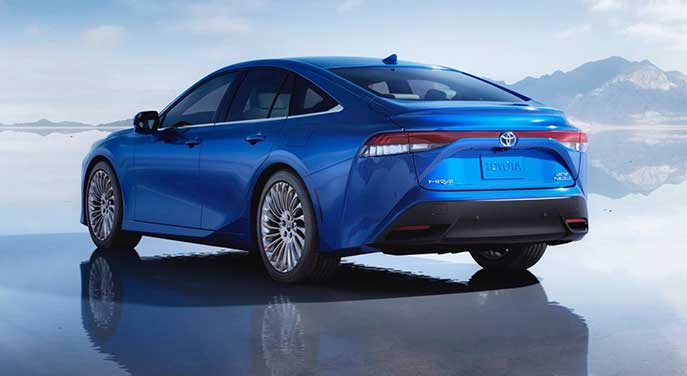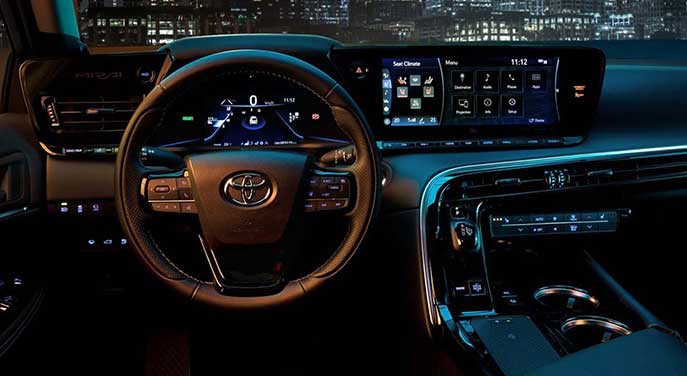
The Toyota Mirai is an absolute knockout stylistically
 Back in the ’80s and ’90s, when alternate fuel technology was at a fever pitch, one of the possibilities that seemed the most promising was hydrogen power. It’s clean burning, abundant, and fuel efficient, and a slew of manufacturers, including Mazda, BMW, and Toyota, spent enormous amounts of time and money pursuing the idea of hydrogen-powered vehicles.
Back in the ’80s and ’90s, when alternate fuel technology was at a fever pitch, one of the possibilities that seemed the most promising was hydrogen power. It’s clean burning, abundant, and fuel efficient, and a slew of manufacturers, including Mazda, BMW, and Toyota, spent enormous amounts of time and money pursuing the idea of hydrogen-powered vehicles.
Ballard Technologies, located in British Columbia, was a world leader with this technology and, for a time, produced a range of experimental buses, trucks and automobiles for various carmakers, all powered by a hydrogen-fueled energy “stack” that produced electricity with zero emissions.
Problem was, the technology wasn’t perfected, and the infrastructure and service network just wasn’t there. Still isn’t. As with any number of automotive innovations, hydrogen power just kind of died on the vine, and “conventional” battery-powered cars rolled into the limelight.
But the dream isn’t over. Toyota recently introduced its Mirai sedan, which is powered by a hydrogen-fed fuel stack in tandem with an electric motor and a single-speed transmission. And this is more than a concept car; you can actually buy one in Canada.
 The Toyota Mirai has all the usual modern conveniences and safety features |
| Related Stories |
| Low-priced Hyundai Venue includes lots of goodies
|
| Buying used: Nissan Altima Coupe well appointed, economical
|
| Electric, hydrogen vehicles offer green bargain for transportation sector
|
| MORE AUTO REVIEWS |
Like virtually all of these types of vehicles, the Mirai’s fuel stack is fed by hydrogen, which is stored in some heavy-duty tanks located under the car’s floor pan. After being bombarded by oxygen collected by the vehicle’s forward momentum, the stack produces electricity, which is sent to and stored in a nickel metal hydride battery pack, which, in turn, powers an electric motor. The Mirai is said to produce some 182 horsepower and has a purported driving range of around 600 to 640 km, with comparable fuel economy set at 3.1 litres per 100 km in town and 3.3 on the highway. The driving experience is seamless, almost completely silent, and surprisingly normal. The car is also completely emissions-free: the only by-product is water.
That said, Toyota’s claim of a 600-plus driving range may be a tad optimistic. My test Mirai, with a full tank of hydrogen, indicated the car could go for around 425 kilometres before refuelling.
Speaking of which, there are precious few refilling facilities in Canada. We seem to be obsessed with conventional battery-powered vehicles these days, and something off the beaten track like the Mirai is just not front and centre when it comes to recharging issues. In B.C, for example, there are just half a dozen recharging stations province-wide, and they’re in urban areas like Vancouver and Kelowna. Refilling time is about five minutes from empty to full.
As well as being an absolute knockout stylistically, the Mirai feels like any other upscale electric car. Power is smoothly delivered and it may be one of the quietest cars I’ve ever driven. Close your eyes, and you could be in a Lexus. A dashboard graphic lets you know how much range you have left, how much fuel is in the tank, the state of the battery charge, and where the power is going. The Mirai is rear-drive and feels much like – oh – a Lexus LS in terms of the driving experience. Effortless, in other words.
Needless to say, it has all the usual modern conveniences and safety features, including touchscreen display, “birds-eye” camera, heads-up display, rear traffic monitor, lane departure warning, heated/ventilated seats, etc., etc. Two models are offered: base XLE and top-of-the-range Limited. Prices are $54,990 and $76,750 respectively, before incentives and rebates. Incentives and rebates depend on where you live and can be up to $5,000 from Ottawa and $3,000 to $5,000 provincially.
Ted Laturnus has been an automotive journalist since 1976. He was named Canadian Automobile Journalist of the Year twice and is past president of the Automobile Journalists Association of Canada (AJAC).
For interview requests, click here.
The opinions expressed by our columnists and contributors are theirs alone and do not inherently or expressly reflect the views of our publication.
© Troy Media
Troy Media is an editorial content provider to media outlets and its own hosted community news outlets across Canada.

